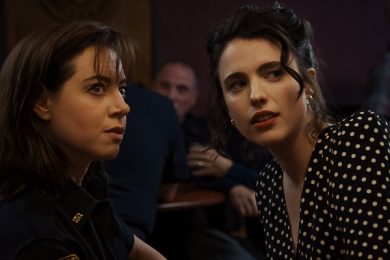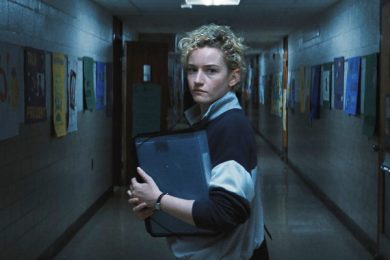The Friend is a film that knows all about the tentpole story beats of the dog movie. It understands – almost too well – the narrative premise of dog-as-metaphor. The film is based on a best-selling novel from Sigrid Nunez; the second Nunez adaptation in the last five months, after December’s Almodóvar film, The Room Next Door. Both films (and, presumably, both books) deal with the emotional burdens of friendship, and coming to grips with mortality and grief. In both stories, our main character is put into a very compromising position by someone they care about, complicated by decades of varied human experience. The Room Next Door is the artier, better film, though The Friend feels lighter, more approachable. The pup at the film’s center is a much-needed boon to the film’s haunted characters.
Naomi Watts plays Iris, a writer and teacher who lives in a small, but rent controlled apartment near the corner of Washington Square Park. The location is one of those quintessential NYC paradoxes: glamorous with conditions, a piece of luxury that must contend with the limits of human space and expectation. It is a beautiful apartment but it requires Iris to keep her life compact, which she’s done now well into her fifties. It’s this late in her life where she meets the biggest threat to that compact life: a massive, middle-aged Great Dane named Apollo. Apollo belonged to her friend Walter (Bill Murray). After Walter committed suicide, his widow (Noma Dumezweni), claims that he wanted Iris to have the dog. The idea seems far-fetched to Iris – she wasn’t a wife or a girlfriend, but merely a friend. But when the widow says she’s put Apollo in a kennel, Iris finally decides to bring Apollo to her much-coveted, very tiny apartment.
Apollo is played by Bing, an 150-pound Great Dane from the Michigan area. Bing joins the ranks of Messi in Anatomy of a Fall as a canine whose star power outshines a good many of the human actors. This is by design, of course. Directors Scott McGehee and David Siegel really do direct Bing, and their camera (director of photography: Giles Nuttgens) frames him as the magnetic showstopper that he is. Apollo’s incredible size inside Iris’s apartment would already be a problem of its own, but it’s metastasized by the fact that her building management doesn’t allow dogs of any sizes, let alone one the proportions of a miniature horse. So this is the central conflict of McGehee and Siegel’s script: the dog vs. the apartment. It’s a very New York hook for a film that gets really intimate with the locations in greater Greenwich Village.
The pair of McGehee and Siegel excel in these kinds of training wheels adult films. The kinds of R-rated movies you’re unafraid to let children see. They respect the structure of good narrative, and never make their filmmaking too slack or too ostentatious. They’re perfectly fine directors even if you’d struggle to fine anything spectacular in any of their films. That is, besides the performances, often from women, that carry their movies into something much more worth watching than what’s on the page. Naomi Watts is far from the first actress to possess a large disparity between the quality of her projects and the magnitude of her talent, but charting the twenty five years between Mulholland Dr. and today, the gap really does feel pronounced. Just by giving her a tried and true leading role that allows her to really play a fully actualized character, The Friend feels very much like a gift.
And Watts is very good in the film, playing a version of grief that is not often portrayed: unmistakable love against your better judgment. Murray’s Walter is a cliche within the literary world: incredibly talented, effortlessly charming, dangerously impulsive, and ultimately too selfish to regard the pain he caused in others. His memorial is littered with women harmed by his poor behavior, including three wives (Dumezweni, as well as Carla Gugino and Constance Wu), and a grown daughter named Val (Sarah Pidgeon), who Walter didn’t even acknowledge until she was an adult. How can Iris reconcile her enduring friendship with a man whose carelessness and infidelity took so much from colleagues and friends? How does she process his own half-hearted seduction of her?
Part of the movie’s weakness is that it never really contends with everything Walter has done to Iris, let alone to everyone else. It prefers to keep Murray’s portrayal as easy-going and grandfatherly. A smarter film would have used that to surprise you with his sinister nature, but The Friend spends much more time watching Iris process all this through Apollo. At two full hours, it does feel like much more time than it should be. McGehee and Siegel understand that Iris is dealing with complicated feelings, but never really takes the full measure. It is, in the end, a dog movie, and it still feels its obligation to check the boxes of growing pains and cuteness. Several scenes where he appears to be her master, and not the other way around. The eventual realization from Iris that her home is not a temporary place for Apollo, but a permanent one.
The script gives Watts some chewy monologues, but she acquits herself admirably, and if I feel like our two directors don’t totally understand the feelings that they’re dealing with, I do not share that same skepticism with Watts’s performance, which is a perfect balance between humor and bereavement, resentful and heartbroken. The movie’s Christmas setting makes this an awkward fit for a April release, and the film’s move from an initial Fall release might have been the first sign that the ceiling was low on just how good this movie could be. The movie is ultimately successful, a two-hander between Watts and Bing, where two special talents showcase the beauty of collaboration. **Spoiler Alert** Despite several references, we don’t have to worry about Apollo dying at the end, one of the cliches of the Dog Movie that The Friend mercifully avoids.
Written for the Screen and Directed by Scott McGehee & David Siegel










